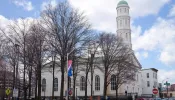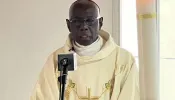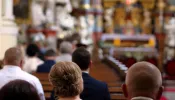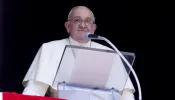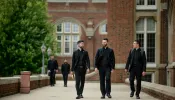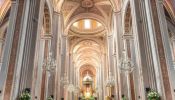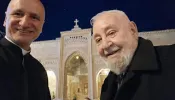When Prince Vladimir of Kiev converted to Christ in AD 988, he wished to bring the gift of the Catholic faith to all his country (what we know today as the Ukraine). So, he sent trusted representatives to request missionaries and to witness the Divine Liturgy celebrated in the beautiful Church of Hagia Sophia (Holy Wisdom) in Constantinople (Istanbul today). They were overwhelmed by the beauty of the Eucharistic Sacrifice and wrote to the prince the following message: "We did not know whether we were in heaven or on earth. Never have we seen such beauty… We cannot describe it, but this much we can say: there God dwells among mankind."
What these Ukrainian envoys experienced was a taste of heaven — indeed more than a taste, a true sacramental sharing in eternal realities. Today, we shall take a closer look at this wondrous aspect of the Eucharistic mystery.
'With the angels and saints we sing'
Not a few people complain that their experience of going to Mass is anything but heavenly. But that says much more about them than about the Mass. In fact, heaven invades earth at every Eucharistic celebration. St. Athanasius wrote of Holy Mass, more than 1,600 years ago, "My beloved brethren, it is no temporal feast that we come to, but an eternal, heavenly feast. We do not display it in shadows; we approach it in reality."
The First Eucharistic Prayer expresses this great truth, when the priest says, "Almighty God, we pray that your angel may take this sacrifice to your altar in heaven. Then, as we receive from this altar the sacred body and blood of your Son, let us be filled with every grace and blessing." It is also evident in the Preface of the Mass; even though there are many Prefaces to choose from, each one culminates in words like these: "And so we join the angels and the saints in proclaiming your glory as we sing: Holy, Holy, Holy…".
This is not just a metaphorical illusion; it is a sacred reality. As Vatican II stated in the Constitution on the Sacred Liturgy (#8), "In the earthly liturgy, by way of foretaste, we share in that heavenly liturgy which is celebrated in the holy city of Jerusalem toward which we journey as pilgrims, and in which Christ is sitting at the right hand of God, a minister of the sanctuary and of the true tabernacle."
All of us struggle with distractions at Mass. Poor homilies or unprepared ministers or off-key music may add to the distractions; but the fact remains, and we must strive always to keep in mind, that a wondrous communion with heaven takes place in the Eucharistic Sacrifice.
One with heavenly warriors
Communion with the saints and angels, while genuine and miraculous, does not remove us from solidarity with others on Earth. It provides no excuse to avoid the responsibilities of Christian life in this world. The army of saints and angels in heaven are not disinterested in our spiritual combat on Earth. Quite the contrary. They are with us in the Sacred Liturgy, and they are with us in daily life in the family and the public square. More importantly, Christ Himself remains with us, precisely through the Eucharist.
At Mass, we unite with Christ in offering to the Father all that we have and all that we are. He, then, takes what is temporal and makes it eternal. He raises what is human into the realm of, and in communion with, what is divine. But the sanctifying power of Christ, our High Priest, does not end there. For, while we are truly citizens of heaven through the Sacred Liturgy, we remain citizens of Earth with a mission in Christ's name to bear witness to the Kingdom of God.
Not only does our heavenly Redeemer break into the temporal realm at Mass but He also remains with us as we fulfill our earthly vocation day by day. Worship prepares us for battle; it prepare our hands and hearts for war, a war not fought with guns and bombs but one fought with the fruit of the Spirit (Cf. Gal 5:22), "love, joy, peace, patience, kindness, generosity, faithfulness, self-control." We can be confident that the Lord will give us victory over evil in the world if we remain one with Him. He will answer our prayer, "Lead us not into temptation but deliver us from evil. Amen."
Eschatological wonder
What we have been considering here is the eschatological dimension of the Sacred Liturgy. Eschatology has to do with the "last things," God's ultimate plan for all He has created. It has to do with those things which will not end with the conclusion of time but will endure throughout eternity. The Lord Jesus was speaking of an eschatological reality when He said (Mt 24:35): "Heaven and earth will pass away, but my words will not pass away."
God created us human beings to live forever with Him in heaven. The Sacred Liturgy helps us keep our eyes fixed on this eternal goal by introducing us into it sacramentally. Christ uses sacred signs and symbols — water, oil, bread, wine, the human body and so forth — to share His life with us and to fill our minds with His light. For this reason, sacred art and architecture, sacred music and the rites themselves are the means by which we encounter and share communion with the Eternal Triune God. We celebrate the Paschal Mystery of Jesus, the Lamb of God who takes away the sins of the world. This mystery of unconquerable love took place in limited confines of time, at a certain moment in human history, nearly 2,000 years ago, but it is not bound by the limitations of time. This is true because the protagonist, the One who died and rose again to redeem us, is the Eternal Word of God, the Beloved Son of the Father.
At Mass, we see a priest celebrating the sacred mysteries, wearing sacred vestments, doing sacred signs, speaking sacred texts; but the Priest who brings about the Eucharistic Mystery and makes Himself present for Holy Communion with us is the Lord Jesus Himself. The priest we can see is acting, during the Sacred Liturgy, in persona Christi. This is why the Church taught at Vatican II (Ibid, #7), "Christ is always present in His Church, especially in her liturgical celebrations. He is present in the sacrifice of the Mass, not only in the person of His minister… but especially under the Eucharistic species… Christ indeed always associates the Church with Himself in the truly great work of giving perfect praise to God and making men holy."
This explains why the Church, at great sacrifice, constructs basilicas, cathedrals, chapels and parish churches of such exquisite beauty. It reflects heaven in stone and glass, eternity in music and built form, because the greatest actions that take place in those sacred edifices are eschatological. Heaven is made present on earth; and we are caught up into eternal realities that will last forever.
Printed with permission from the Catholic Sun, newspaper for the Diocese of Phoenix.


